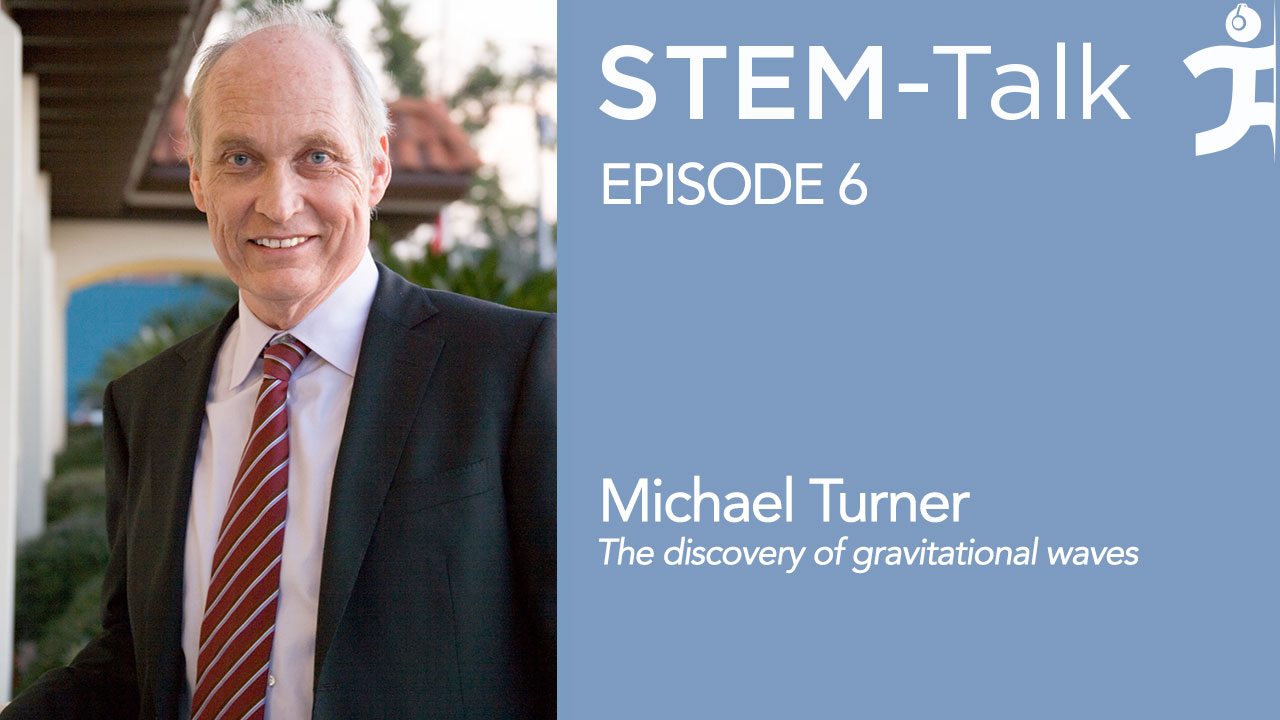STEM-Talk
Episode 6: Michael Turner discusses LIGO & the detection of gravitational waves
// Apr 5, 2016

Michael Turner is best known for having coined the term “dark energy” in 1998. A theoretical cosmologist at the University of Chicago, Turner has dedicated his career to researching the Big Bang, dark energy and dark matter.
He wrote his Ph.D. thesis on gravitational waves—back in 1978—and nearly four decades later—had a bird’s eye view of their recent detection. Turner was assistant director of the National Science Foundation (NSF), which funded the development of LIGO, which stands for the Laser Interferometer Gravitational-Wave Observatory.
This large-scale physics experiment and observatory, which was led by researchers at MIT and CalTech, discovered, on September 15th, 2015, the existence of gravitational waves via a chirping noise signaling the merger of two black holes over a billion light-years away. The scientists announced their discovery on February 11th, 2016.
In this episode, Turner interprets this momentous finding, and talks about some of the big player scientists who worked on LIGO. And some of the behind the scenes activities involved in a “big science” project such as LIGO.
Talking with STEM-Talk host Dawn Kernagis, Turner also shares his early development as a scientist and an important mentorship that shaped his career.
Turner has been a popular presence at IHMC as a guest lecturer. His IHMC talks have over 20,000 YouTube views. https://youtu.be/-rVBLwKuDXA
He is also co-author, with Edward Kolb, of The Early Universe:
1:18: IHMC CEO Ken Ford explains what gravitational waves are.
4:29: Five-star reviews of STEM-Talk on iTunes are starting to roll in. Ken Ford reads one from ‘Bobalapoet’: “The individuals interviewed are articulate, knowledgeable and able to clearly convey information about their fields. The interviewers and the institute are to be congratulated for putting this series together for my and others’ enjoyment.”
6:18: Turner talks about his childhood interest in science. “I was always a curious kid,” he said. He tinkered with electronics and became a ham radio operator, talking to people all over the world. “I almost electrocuted myself several times.”
7:21: “I like to say that I went to best schools that money could buy, in the 1960s, which was public schools in California.” Turner describes various high school chemistry experiments and “creating UFOS over LA.” He loved math, physics, and chemistry.
8:58: Turner discovers that physics is his real passion, and “math was but a tool.”
9:05: Turner’s high school physics teacher took Turner and friends to Monday night lectures at CalTech. “It just opened up this world of stuff that was going on at the forefront of science,” adding that’s when he fell in love with what would become his undergraduate alma mater.
11:00: For his Ph.D., Turner went to Stanford on the advice of Nobel Prize winning physicist Richard Feynman.
11:36: Turner went to the University of Chicago in 1978 as an Enrico Fermi fellow. Initially his plan was to return to California as soon as possible, but “I’ve been happily in Chicago ever since.”
12:09: David Schramm, an astrophysicist and Big Bang theory expert, brought Turner to Chicago and mentored him until Schramm’s tragic death from a plane crash in 1997. The two met at CalTech, in the gym, where Schramm was assistant wrestling coach.
14:45: “Dave curved the path of my career from astrophysics and gravitational waves to early universe cosmology.”
16:41: “[Dave’s] toughness and his enthusiasm for science are things that I take with me to this day.”
17:00: “[Dave] really changed the face of cosmology and astronomy at the University of Chicago.”
17:25: Commercial break: STEM-Talk is an educational service of the Florida Institute for Human and Machine Cognition, a not-for-profit research lab pioneering ground-breaking technologies aimed at leveraging human cognition, perception, locomotion and resilience.
17:58: Turner discusses his passion for bicycling. He says Chicago is a great place to train because the weather makes you “Chi-town tough.”
18:58: Turner elaborates on calling the gravitational waves discovery “the last big prediction of the theory of relativity.”
20:58: Turner calls the discovery “a Galileo moment.” “Four hundred years ago Galileo turned the telescopes to the sky, and opened their eyes to the universe, and now we have this new window on the universe.”
22:55: “Galileo would be smiling” about the discovery since he said “make measurable that which is not measurable.” Turner says the challenge in building a gravitational wave detector was to be able to measure such a small distance change over such a large distance.
24:00: When Turner wrote his thesis on gravitational waves in 1978, he thought their discovery was around the corner. It took fifty years.
24:38: The NSF thought LIGO was “moonshot worthy to do.”
25:20: Turner talks about some of the scientists who worked on tools used during LIGO such as the Michelson interferometer (invented by Alan Michelson.)
26:40: LIGO uses lasers and interferometry.
30:11: NSF looked at the proposal for LIGO in the early 1990s and said, “This is a lofty goal. Let’s do this.” CalTech and MIT led the way.
31:05: Turner credits Barry Barish, experimental physicist at CalTech, with really getting the project going.
31:40: LIGO was done in two phases.
33:19: Turner had to make a recommendation to the Director of NSF and subsequently to the National Science Board (which has oversight on large-scale science projects) about continuing the project into the second phase. “It took more than a year for the Board to decide, but they stuck with it.”
35:14: “LIGO is going to earn its O, and become a real observatory. This is going to become a new window on the universe.”
37:00: This discovery qualifies as “Big Science,” a relatively new, post WWII phenomenon.
37:30: “I always harken back to John Kennedy’s quote about going to the moon. He talked about how going to the moon is really hard and said, ‘that’s why we’re doing it.’”
38:18: “Ken Ford was one of these wise people on the National Science Board. They’re the adult supervision in the room.” Turner explains that the Board had to do due diligence to make sure the project was worthy of continuing.
41:31: “These people [National Science Board] were doing a service to the country: by making sure we were spending the money wisely. And also making sure we were taking the calculated risks” behind those really big advances.
43:24: “This is an example where we as Americans can be very proud. Now, other nations including Japan, Germany, and the UK are making investments, but we really led.”
46:48: A year from now, Virgo, the European detector for gravitational waves located near Pisa, Italy, will be done with its upgrades.
49:38: The legacy of the gravitational waves? “The most exciting thing is the thing we haven’t thought of. If history is any guide, there will be wonderful discoveries that will take us in new directions when we open up a new window on the universe.”
51:00: Turner’s next STEM-Talk podcast will be on dark energy and dark matter.
51:23: Also soon up on STEM-Talk: Cal-Tech physicist Barry Barish. Ford says, “I can say with complete confidence that LIGO would not have been successfully constructed without Barry.”






